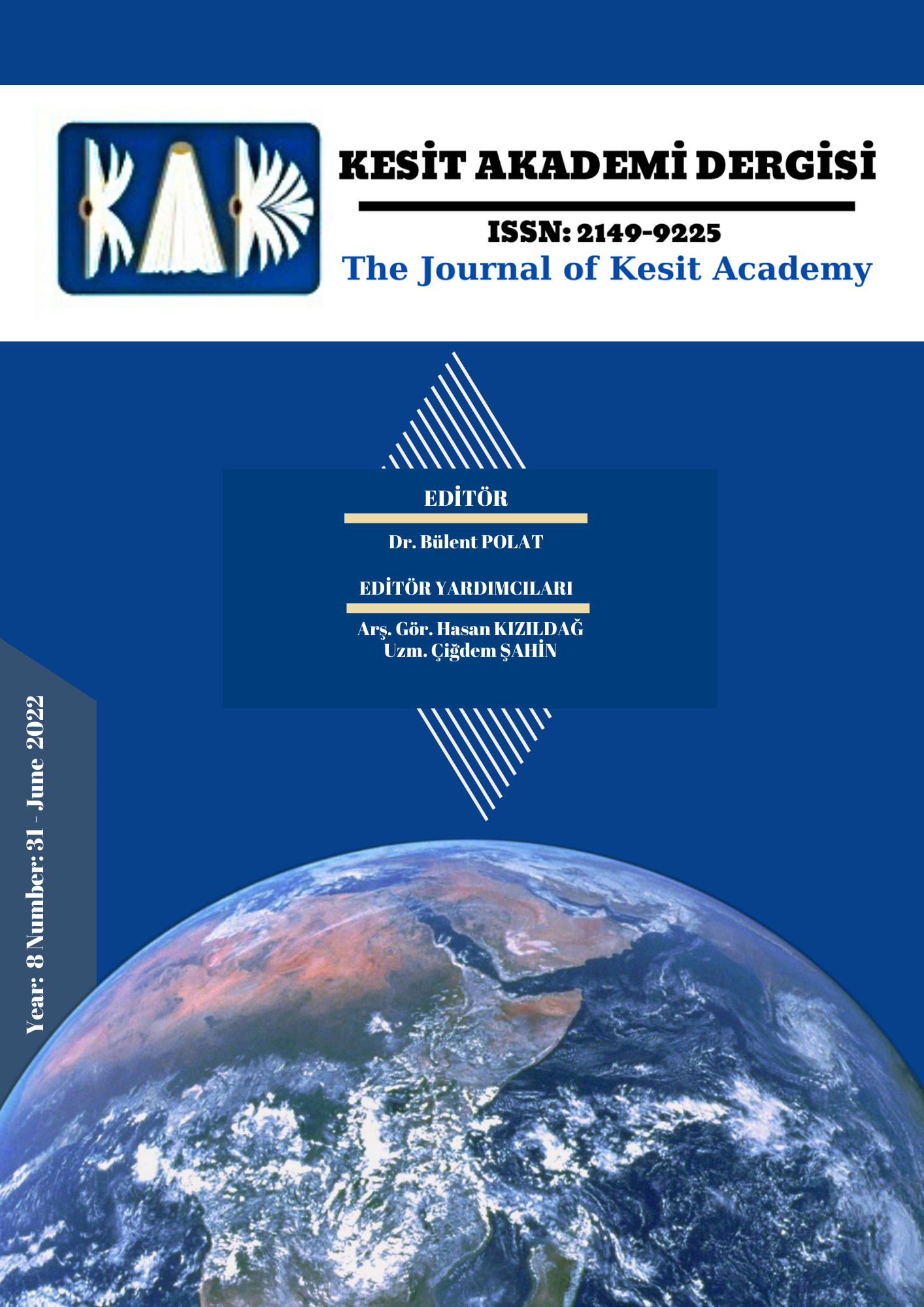Author :
Abstract
Joseph Beuys ikinci dünya savaşı sonrası batı sanatı içerisinde yer alan önemli Alman sanatçılardan biridir. 1961 yılında Düsseldorf Sanat Akademisi’nde heykel profesörü olarak çalışmaya başlamasıyla, sanatçılığının yanında sanat eğitimine dair kendine has pedegojik yaklaşımın da öne çıktığı görülmektedir. Düşünür Rudolf Steiner’in Beuys üzerindeki etkisi bu yaklaşımın gelişmesinde önemli bir yer tutar. Sanatçının hayatı sanat, eğitim ve sosyal politikalar üzerine düşünmek ve üretmek üzerine kurulmuştur. Beuys’un sanatı incelendiğinde bunların birbirini beslediği görülecektir. Ona göre sanatın yaratıcı, dönüştürücü üretken gücü dünyayı, toplumu daha özgür ve mutlu kılacak yolun anahtarıdır. Sanat eğitimin, düşünce üretmenin ve paylaşmanın en etkili yoludur. Bu yüzden eğitim özgür bir ifade, tartışma ve paylaşım alanı haline getirilmelidir. Böylece bireyin demokratik varlık alanı genişletilebilir, toplum özgürleşerek yaratıcılığını keşfetmeye açılabilir. Beuys’un sanatına bakıldığında bu amaç açıkça görülür. Sanatın tanımı genişletilerek düşünce ve eylem alanı haline gelmiştir. Aksiyolarında ve heykellerinde ana akım estetik beğeni normlarını aşma, duyarlığın tinsel alanına ulaşma(,) hayal gücünü serbest bırakma iddiasındadır. Beuys bunun için yol gösteren, iyileştiren, öğreten, önderlik eden kimlikleri toplayan bir persona inşa etmiştir. Doğum, ölüm ve yeniden doğuş evrelerini deneyimleyen kişisel mitosunu da bu personayı destekleyecek bir çekim noktası haline getirebilmiştir. Pilot yeleği, keçe şapkası, zaman zaman aksiyonlarında görülen bastonu ve kürk mantosu ile bu kimliğe ait kostümü yaratmıştır. Bu makalede Joseph Beuys’un sanatçı personasının ana hatları incelenerek Jung’un personanın inşası kavramı bağlamında sanatına etkileri değerlendirilecektir.
Keywords
Abstract
Joseph Beuys is one of the important German artists involved in western art after the second world war. He started to work as a professor of sculpture at the Düsseldorf Art Academy in 1961, and it is seen that his unique pedagogical approach to art education came to the fore besides his artistry. The influence of the philosopher Rudolf Steiner on Beuys has an important place in the development of this approach. The life of the artist is based on thinking and producing on art, education and social policies. When we pay attention to Beuys' art, it will be seen that they feed each other. For him, the creative and transformative productive power of art was the key to making the world and society more free and happy. Art is the most effective way of education, generating and sharing ideas. Therefore, education should be made a free expression, discussion and sharing domain. Thus, the democratic existence of the individual could be expanded, and the society could be liberated and opened to discovering his creativity. This purpose becomes clear when looking at Beuys' art. The definition of art has been expanded and it has become a field of thought and action. In his actions and sculptures, he claims to go beyond the norms of aesthetic taste, to reach the spiritual realm of the sensibility and to free the imagination. For this, Beuys has built a persona that collects identities that guide, heal, teach and lead. He was able to turn his personal myth of experiencing the stages of birth, death and rebirth into a point of attraction to support this persona. He created the costume belonging to this identity with his pilot vest, felt hat, cane and fur coat seen from time to time in his actions. In this article, the main lines of Joseph Beuys' artist persona will be examined and the effects on Jung's art in the context of the concept of persona construction will be evaluated.
Keywords
- Antliff, A. (2014). Joseph Beuys. Phaidon Press.
- Adriani, G., Konnertz, W., & Thomas, K. (1979). Joseph Beuys: life and works (Çev.: P.Lech). Barron's Educational Series Inc.
- Beuys, J. (1986). In memoriam, Joseph Beuys: obituaries, essays, speeches. Inter Nationes.
- Beuys, J., Böll, H., (1990). Manifestio the foundation of a free International school for creati- vity and interdisciplinary research. İçinde Kuoni, C. Energy Plan For The Westrnman Joseph Beuys In America. For Walls Eight Windows.
- Beykal, C. (1992). Beuys: 5 kasım 1991 salı, 6 kasım 1991 çarşamba. 7 kasım 1991 perşembe (üç gün). Plastik Sanatlar Derneği Yayın Dizisi.
- Biesta, G. (2017). Letting art teach-art education ‘after’ Joseph Beuys. ArtEZPress.
- Burkchardt, T. (2017). Simya (Çev.: M. Temelli). Verka Yayınları.
- Campbell, J. (2006). İlkel mitoloji (Çev.: K. Emiroğlu). İmge Kitabevi.
- Danto, A. (2010) Sanatın sonundan sonra (Çev.: Z. Demirsu). Ayrıntı Yayınları.
- Frank Gieseke, A. M. (1996). Flieger, filz und vaterland: eine erweiterte Beuys biografie. Elefanten Press.
- Jung, C. G. (2015). Dört arketip (çev.: A. Oysal). Metis Yayınları.
- Martin, S. (2009). Simya ve simyacılar (Çev.: E. Ç. Babaoğlu). Kalkedon Yayınları.
- Merdaner, E. (2016). Joseph Beuys ”sanatı ve felsefesine bir bakış”. Tekhne Yayınları
- Nisbet,P. (2001). Chrashing course. İçinde Ray, G. (Ed.). Joseph Beuys, Mapping The Legacy, D.A.P. Disturbuted Art Publishers.
- Perrin, M. (2016). Şamanizm (Çev.: B. Arıbaş). İletişim Yayınları.
- Richter, P. (2009). Bir öğretmen olarak Joseph Beuys-kendini keşfetmeye davet. İçinde Anadol, Ç. (Ed.), Joseph Beuys ve Öğrencileri Deutsche Bank Koleksiyonundan Seçmeler. (s.16-23), Aksoy Matbaa.
- Ulmer, G.L. (2019). Applied grammatology: post(e)-pedagogy from Jacques Derrida to Joseph Beuys. John Hopkins University Press.
- Veiel, A. (Yöneten). (2017). Beuys [Sinema Filmi].Piffl Medien
- URL-1 Görsel 1: ‚Ölü Bir Tavşana Resimler Nasıl Açıklanır‛, 1965. https://www.artgallery.nsw.gov.au/collection/works/434.1997.9/ (Erişim Tarihi: 12.02.2022)
- URL-2: Buchloh, Krauss, Michelson, (1980). Joseph Beuys at the guggenheim. MIT Press. October, Spring. 1980, Vol. 12, pp. 3-21. https://doi.org/10.2307/778572 (Erişim Tarihi: 09.05.2021)
- URL-3 Görsel: 2: Beuys 1970 Yılında Frankfurt’ta öğrencilerinin sergisinde. https://www.frieze.com/article/katharina-sieverding-joseph-beuys-2021 (Erişim Tarhi: 12.02.2022)
- URL-4 Görsel: 3: Joseph Beuys, ‚Uluslararası Özgür Üniversite‛ Bayrağı, (F.I.U. Flag), 1985 MACBA Collection. Government of Catalonia long-term loan. National Collection of Art. The Joseph Beuys Estate, VEGAP, Barcelona, 2022. https://www.macba.cat/en/art-artists/artists/beuys-joseph/fiu-flag (Erişim Tarihi: 21.042022)
- URL-5: Kılınçarslan, R.Ö. (2022). Joseph Beuysun anısına: 1980’lerden bir sergi ve izmir çağdaş sanat ortamına etkisi. Art-Sanat İstanbul Üniversitesi Yayınevi. 17, 253-273. 10.26650/artsanat.2022.17.984180 (Erişim Tarihi: 21.05.2022)
- URL-6: Çekil, C., Beuys ve biz.https://archives.saltresearch.org/handle/123456789/47798 (Erişim Tarihi: 10.02.2022)





